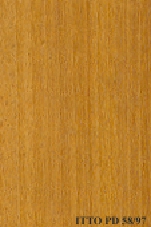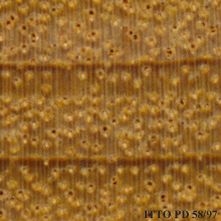
TOLA (Gossweilerodendron balsamiferum)
Trade Name
Tola
Scientific Name
Gossweilerodendron balsamiferum Harms
Family
LEGUMINOSAE
Common Names
Otabo (Nigeria); Agba (Nigeria); Otabo (United Kingdom); Agba (United Kingdom); Tola branca (Germany); Agba (Germany); Tola (Zaire); N'tola (Zaire); Emolo (Gabon); Tola (Congo); N'tola (Congo); Sinedon (Cameroon); White tola; Tshibudimbu tshitoke; Pink mahogany; Okimeten; Ntola; Nigerian cedar; Mutsekamambole; Mushilu mutoke; Mupaka; Mpere; Mpele; Moboron; Mboron; Loshi-erin; Emonga; Ditchipi; Dembo; Boana; Agbara; Achi-aro; Achi; N`tola (Zaire); Tola branca (Angola); Tola blanc (Zimbabwe); Tola blanc (Congo); Emongi (Nigeria); Egba (Nigeria); Agba; Tola
Scientific Name Synonyms
Pterygopodium balsamiferum Vermoesen
Description Of The Tree
Botanical Description
The tree reaches a height of more than 50 m, with trunk diameters up to 170 or even 200 cm. The bole is clear and straight to 26 to 30 m in length and more.
Natural Habitat
Gossweilerodendron balsamiferum grows in mature little-disturbed lowland rainforest. It is known or inferred that the harvesting of specimens from the wild for international trade has, or may have, a detrimental impact on the species by EITHER. Exceending
Natural Distribution
West and Central Africa, from Nigeria to the Democratic Republic of the Congo.
Non Timber Uses
Contains some resins or extracts which could pose problems when machining or finishing.
Wood Identification
Anatomic Description Of Wood
Wood diffuse porous. Occasionally vessels exclusively solitary (over 90%). Tangential diameter of vessel lumina 100 to 150 micras (small). Vestured pits. Vessels per mm2 6 to 10 (medium). Simple perforation plates. Vessel-ray pits similar to intervessel pits in Axial parenchyma in marginal or in seemingly marginal bands. Paratracheal axial parenchyma scanty and/or vasicentric. Axial parenchyma lozenge-aliform. Prismatic crystals in chambered axial parenchyma cells and/or in fibers. 5 to 8 cells per parenchyma strand 4 to 10 rays per mm (medium). Rays non-storied. Rays 1 to 4 seriate. Homogeneous rays and/or sub-homogeneous rays (all ray cells procumbent).
-
 Wood Macro Photo Tangential Plane
Wood Macro Photo Tangential Plane
-
 Wood Micro Photo Of Transversal Section
Wood Micro Photo Of Transversal Section
Availability
Cites Status
Unrestricted
General Wood Description
Odor
Peppered odor.
Color
The sapwood is whitish, it has a thickness of 10 cm. The heartwood is pinkish yellow-brown, darkening on exposure, it is not clearly demarcated. The silver figure is fine.
COLOR INDEX (1=Black, 7=Light yellow,white)
5
Grain
Straight or slightly interlocked, sometimes with an influence on further processing operations.
Texture
The texture is typically medium to coarse.
Luster
It is reported to be low in luster.
Natural Durability
Because of its variable resistance it is considered as moderately durable to decay. Without treatment, it can be used when risks of occasional re-humidification; it is not suited for uses with risks of permanent or long-lasting humidification. Sensible to
Natural durability index (1= Very high durability, 7=Vey low durability)
4
Internal Growth Stresses
No residual stresses are reported in this species.
Resistance To Impregnation
Difficult to treat with only a low penetration of the preservative products.
Wood Physical Properties
Basic Density or Specific Gravity (O.D. weight/vol. green) (g/cm³)
0.48
Air-dry Density (Weight and volume at 12%MC) (g/cm³)
0.52
Total shrinkage Tangential (Saturated to 0%MC) (%)
5.4
Total shrinkage Radial (Saturated to 0%MC) (%)
2.4
Drying Defects
Ease of Drying: Drying is moderately easy; some particular care is needed. Drying Defects: Risks of casehardening and checks Kiln Schedules: Schedule proposed as a reference by comparison with well known species taking into account to the general technological behavior of this species.
Recommended Dry Kiln Schedule
FR-1
Dimensional stability ratio (Total Tangential Shrinkage %/Total Radial Shrinkage %)
2.3
Wood Chemical Properties
Wood Mechanical Properties
Bending Strength (MOR),12%MC (kgf/cm²)
754
Stiffness (MOE) 12%MC (kgf/cm²)
111290
Compression parallel to fiber 12%MC (kgf/cm²)
408
Compression perpendicular to fiber 12%MC (kgf/cm²)
47
Shear strength radial 12%MC (kgf/cm²)
69
Janka hardness (side) 12%MC (kgf)
326
Janka hardness (end grain) 12%MC (kgf)
429
Workability
Sawing
It is easy to saw.
Rotary Veneer Cutting
Suitable for slicing and peeling.
Sliced Veneer
Suitable for slicing and peeling.
Blunting Effect
Slight blunting effect; ordinary tools can be used for sawing and machining.
Machining
Machining of this species is reportedly easy.
Planing
Easy; no particular problems.
Moulding
Moderately easy; tools must be cautiously sharpened.
Boring
Moderately easy; tools must be cautiously sharpened.
Mortising
Moderately easy; tools must be cautiously sharpened.
Nailing
No particular problem.
Gluing
Difficult to glue because of the extracts content.
Sanding
Easy to perform; it gives good results.
Polishing
Needs pre-coating.
Response To Hand Tools
No particular problems.
REFERENCED USES
End Uses Summary
HOUSING GENERAL, beams, joists, boards, frames, steps, panelling, fittings, shutter boards, FURNITURE AND CABINETS, common furniture, PLYWOOD AND VENEER, faces, Decorative veneer, PACKING, heavy packing, pallets, NAVAL CONSTRUCTION, boat deck, port storage, OTHER AND MUSICAL INSTRUMENTS, door core, shingle, coffin, moldings
General Housing
- 10 - Silica in Timbers
Beams
- 11 - Prospect: The wood database
Joists
- 12 - Tropical timbers of the world. Part I-Tropical American Species
Boards
- 13 - Dry kiln schedules for commercial woods. Temperate and tropical. Section III. Latin American (Mexico, Central, and South America) Woods–Conventional Temperatures
Frames
- 16 - Woods of the World
Steps
- 17 - Tree Conservation Database
Paneling
- 18 - W3TROPICOS Missouri Botanical Garden
Fittings
- 19 - Silica in Timbers
Shutter Boards
- 20 - Prospect: The wood database
Furniture Cabinets
- 21 - Tropical timbers of the world. Part III-Southeast Asian and Oceanian Species.
Furniture, Common
- 23 - Handbook of Hardwoods
Panels, Veneers
- 25 - Directory of Timber Trade Malaysia
Faces
- 26 - Annual Review and Assessment of the World Timber Situation 1998-ITTO
Decorative veneer
- 28 - Ministry of Agriculture, Fisheries & Forest of Fiji
Packing
- 45 - Recopilación y Análisis de Estudios Tecnológicos de Maderas Peruanas
Heavy Packing
- 47 - Arvores Brasileiras
Pallets
- 48 - The strength properties of timbers
Shipbuilding
- 55 - Tropical Timber Atlas of Latin America
Boat Decking
- 59 - Programa Nacional de uso Sostenible de los Bosques e Incremento a las Exportaciones.
Port Storage
- 62 - Estudio Tecnológico de Maderas del Perú (Zona Pucallpa) Vol I
Door Cores
- 76 - Descripción General y Anatómica de 105 Maderas del Grupo Andino.
Shingles
- 77 - Amazonian Timbers, Characteristics and Utilization Volume I; Tapajós National Forest
Coffin
- 78 - Amazonian Timbers for the International Market
Molding
- 79 - Padronização da Nomenclatura Comercial Brasileira das Madeiras Tropicais Amazônicas, Sugestão
Please Provide Information To View Producer Information